
It’s a common saying on Wall Street—cut your losses short and let the winners run. Of course this saying is meant from an investor’s perspective. What about the businessman’s perspective?
Owning and operating your own business isn’t an easy task. There are plenty of risks, dotting at each interval with little to no chances of succeeding.
Some of these risks are purely operational like loss of a regular paycheck, having unsteady cash flow, loss of an exorbitant amount of personal money. Proper check and balance of these risks is usually conducted by business owners.
However, many don’t even wonder about ways to protect their business assets, which can become the gravest risks of all.
Business Assets – Why Are They Important
It’s an asset that helps keep a business afloat. These can be sold off during lean times and can also be used as collateral especially during business expansion. Business assets help create a healthy balance sheet at the end of the year.
An asset can be categorized into one of the following three categories:
- Tangible
- Intangible
- Intellectual property
Value Of Your Business Assets Is High – Are You Valuing Them Enough?
Not knowing what types of assets your business owns is the first mistake when it comes to protecting them. You must have a clear understanding of each type of asset and exactly how they are used in your business.
As mentioned above, assets are classified in 3 different ways and have further sub-categories. These assets will be listed in your balance sheet as either current or non-current.
Current Asset – Is something that can be easily converted into cash. Examples of current business assets are foreign cash reserves, stock inventory, and other investments that can be liquidated easily.
Non-Current Asset – Is something that might take more than one year to show its cash value. Examples are land, property, power plants and machinery.
The best way to find out just how liquid your business assets are is by compiling a list of all current, non-current as well as tangible/non-tangible assets to conduct a comparative analysis.
Understand Risks to Your Assets
The first rule of asset protection is to understand the risks. For example, a disgruntled customer or employee can sue your business which is one risk that potentially jeopardizes business as well as personal assets.
Diversify Operations
This is another effective asset protection tip for businesses.
Having a clear differentiation between brand names registered or setting up additional facilities as standalone entities will provide additional protection. This way even if you are sued, the rest of your operations will go about normally.
There are other asset loss prevention tips that can be implemented depending on the scale of your business. A&B Accounting & Business Solutions can point you towards the right direction when it comes to asset protection and management. Contact us today!





